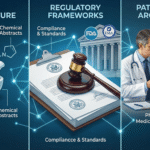The development of antimicrobial agents stands as one of the most significant achievements in medical history. From ancient remedies to the modern era of targeted chemotherapeutics, the journey of these life-saving drugs illustrates remarkable ingenuity, scientific progress, and ongoing challenges such as antimicrobial resistance.
Early Observations and Ancient Remedies
Humans used moulds, plant extracts, and fermented materials with antimicrobial properties for centuries. Ancient Egyptians and Greeks applied poultices and herbal mixtures for wound care, exploiting natural antimicrobial effects before the advent of microbiology.
Birth of Modern Antimicrobial Chemotherapy
- Paul Ehrlich’s “Magic Bullet” (1909): German scientist Paul Ehrlich pioneered systematic chemical screening, leading to the discovery of Salvarsan (arsphenamine, Compound 606), the first effective synthetic antimicrobial for syphilis. Ehrlich influenced the concept of selective toxicity—targeting microbes without harming the host.
- Prontosil and Sulfa Drugs (1930s): Gerhard Domagk’s discovery of prontosil, a red dye, led to the development of sulfanilamide and other sulfonamides—the first widely used synthetic antibacterials, effective against Gram-positive bacteria.
The Antibiotic Era
- Penicillin (1928, clinical use 1940s): Alexander Fleming’s observation of Penicillium mold inhibiting Staphylococcus growth ushered in the modern age of antibiotics. Clinical application of penicillin during WWII revolutionized infection control and saved millions.
- Streptomycin (1943): Selman Waksman and colleagues isolated streptomycin, the first drug effective against tuberculosis, signaling the importance of soil microorganisms as antibiotic sources.
- The “Golden Age” (1944–1966): Discovery and development of natural product antibiotics peaked, yielding major classes:
Synthetic and Semi-Synthetic Advances
- Synthetic agents: Quinolones (1962), trimethoprim (1968), and later oxazolidinones (linezolid, 2000), lipopeptides (daptomycin, 2003) further expanded options. Scientists began modifying and optimizing natural antibiotics, improving stability, spectrum, and activity.
- Combination agents and β-lactamase inhibitors: Combinations like amoxicillin-clavulanate deployed enzyme inhibitors to combat resistance mechanisms.
Expanding Horizons
- Antifungal and antiviral discoveries: Nystatin and amphotericin B for fungi; acyclovir for viruses showed that selective toxicity could extend beyond bacteria.
- Antiparasitics: Innovations against malaria, helminths and protozoa marked ongoing growth in the field.
Challenges and the Decline in Novel Agents
- By the 1980s, most major antibiotic classes were discovered; since then, new classes have been rare.
- Resistance spread rapidly, diminishing the effectiveness of earlier classes and prompting renewed focus on old drugs, combinations, and stewardship.
- The “post-antibiotic era” debate began in response to superbugs and waning industry interest in new antimicrobial development.
Modern Developments and the Future
- Biotechnological innovations: engineered antibiotics, bacteriophage therapy, antimicrobial peptides, and nanomaterial-based agents.
- Structure-activity optimization: focus on halogenated drugs, targeting antimicrobial-resistant pathogens.
- Emphasis on global surveillance, stewardship, and the “One Health” approach.
Timeline of Major Antibiotic Discoveries
| Year | Drug/Class | Milestone |
|---|---|---|
| 1909 | Salvarsan | First synthetic antibacterial |
| 1928/40s | Penicillin | First natural antibiotic (clinical use) |
| 1930s | Sulfa drugs | First widely used synthetic agent |
| 1943 | Streptomycin | First TB antibiotic |
| 1944–60s | Tetracyclines, aminoglycosides, macrolides, cephalosporins | Golden age of discovery |
| 1962 | Quinolones | First synthetic broad-spectrum agent |
| 1980s | Carbapenems, monobactams | Broad-spectrum β-lactams |
| 2000s | Oxazolidinones, lipopeptides | New class; rare since |
References
- Aminov RI. A Brief History of the Antibiotic Era: Lessons Learned and Challenges for the Future. Front Microbiol. 2010;1:134.
- ScienceLearn NZ. Antibiotics and antimicrobial resistance – a timeline. 2025.
- Gould K. Antibiotics: from prehistory to the present day. J Antimicrob Chemother. 2016 Feb;71(3):572-575.
- History of Chemotherapy and Antimicrobial Discovery. Ecampus Ontario. 2019.
- Saga T. History of Antimicrobial Agents and Resistant Bacteria. Med. Or J. 2009;103-108.
- Conly JM. Where are all the new antibiotics? Can J Infect Dis Med Microbiol. 2005 Apr;16(2):95-98.
- Demain AL, Elander RP. Beta-lactam antibiotics: Past, present, and future. Afr J Biomed Res. 2008;11:1-13.
📚 AI Pharma Quiz Generator
🎉 Quiz Results
Medical Disclaimer
The medical information on this post is for general educational purposes only and is provided by Pharmacology Mentor. While we strive to keep content current and accurate, Pharmacology Mentor makes no representations or warranties, express or implied, regarding the completeness, accuracy, reliability, suitability, or availability of the post, the website, or any information, products, services, or related graphics for any purpose. This content is not a substitute for professional medical advice, diagnosis, or treatment; always seek the advice of your physician or other qualified health provider with any questions you may have regarding a medical condition and never disregard or delay seeking professional advice because of something you have read here. Reliance on any information provided is solely at your own risk.








